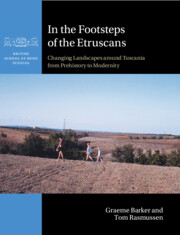Book contents
- In the Footsteps of the Etruscans
- British School at Rome Studies
- In the Footsteps of the Etruscans
- Copyright page
- Dedication
- Contents
- Figures
- Tables
- Contributors
- Preface and Acknowledgements
- 1 The Tuscania Archaeological Survey: Rationale, Aims and Objectives
- 2 Methodologies
- 3 The Natural Landscape and Its Evolution
- 4 Prehistoric Landscapes
- 5 Etruscan Urbanization, c. 700–300 bc
- 6 ‘Romanization’: The Roman Republican Period, c. 300–30 bc
- 7 The Roman Imperial and Late Antique Periods, c. 30 bc–c. ad 700
- 8 Incastellamento and Its Aftermath: Medieval and Modern Landscapes, c. ad 700 to the Present
- 9 A Mediterranean Landscape from Prehistory to Modernity
- Book part
- Bibliography
- Index
8 - Incastellamento and Its Aftermath: Medieval and Modern Landscapes, c. ad 700 to the Present
Published online by Cambridge University Press: 12 October 2023
- In the Footsteps of the Etruscans
- British School at Rome Studies
- In the Footsteps of the Etruscans
- Copyright page
- Dedication
- Contents
- Figures
- Tables
- Contributors
- Preface and Acknowledgements
- 1 The Tuscania Archaeological Survey: Rationale, Aims and Objectives
- 2 Methodologies
- 3 The Natural Landscape and Its Evolution
- 4 Prehistoric Landscapes
- 5 Etruscan Urbanization, c. 700–300 bc
- 6 ‘Romanization’: The Roman Republican Period, c. 300–30 bc
- 7 The Roman Imperial and Late Antique Periods, c. 30 bc–c. ad 700
- 8 Incastellamento and Its Aftermath: Medieval and Modern Landscapes, c. ad 700 to the Present
- 9 A Mediterranean Landscape from Prehistory to Modernity
- Book part
- Bibliography
- Index
Summary
Our survey revealed very few sites belonging to the Early Medieval period (AD 700-1000) apart from Tuscania, indicating a combination of population decline and abandonment of the countryside for the security of the town. There was significant demographic growth in the High Medieval period (AD 1000-1200): 38 sites, together with 30 sites with ‘generic Medieval’ material likely to belong to this phase. The new foundations, distributed throughout the survey area, comprised nucleated but unfortified settlements, a habitation form about which the documentary record is largely silent. In the Late Medieval period (AD 1200-1500: 16 sites), new foundations were established within a few kilometres of Tuscania with little evidence for settlement in the countryside beyond. Most farmers preferred to live in defensible castelli, or within the vicinity of Tuscania. As elsewhere in Italy, the second half of the 2nd millennium has witnessed the increasing abandonment of many small farms by peasant (contadini) families in the face of urban growth and industrialization, with globalization in recent decades accelerating their replacement and absorption by agribusinesses, and the flight to the countryside by middle class commuters from Rome.
Keywords
- Type
- Chapter
- Information
- In the Footsteps of the EtruscansChanging Landscapes around Tuscania from Prehistory to Modernity, pp. 246 - 277Publisher: Cambridge University PressPrint publication year: 2023



